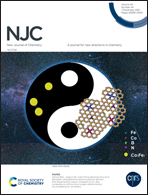Enhanced analytical and physical characterization of mixtures of random bay-position chlorinated boron subnaphthalocyanines enabled by an established partial separation method (a part 2)†
Abstract
The partial separation by column chromatography and characterization of pentafluorophenoxy-(chloro)n-boron subnaphthalocyanines (F5–ClnBsubNcs), a set of bay position chlorinated BsubNcs, has been conducted. This study is a follow up to our previous work whereby we were able to form a separation methodology that enabled the first example of the separation of bay position brominated BsubNcs (ArO–BrnBsubNcs) whereby axial phenoxylation is part of the macrocyclic design that enables separation. This study utilizes the same methodology to show the first example of partially separating the mixture of bay position chlorinated BsubNcs with an axial pentafluorophenoxy element (F5–ClnBsubNcs). The composition of each separated band was analytically characterized by HPLC, NMR, and MS to determine the compositions of each band; specifically, the quantification of bay-position chlorination. The photo-stability of the F5–ClnBsubNcs was determined under various conditions in solution of toluene and the higher level of bay position chlorination was found to increase the solution photostability of the F5–ClnBsubNc relative bands. The physical properties of a non-separated batch of F5–ClnBsubNcs and the separated bands were investigated photophysically and electrochemically for trend points of comparison of each band and to also compare against the past separated bay position brominated F5–BrnBsubNcs. In line with our previous study of F5–BrnBsubNcs, higher bay position chlorination of F5–ClnBsubNcs was found to decrease ΦPL, decrease the Stokes shift, red shift the absorption and emission maxima, as well increase the oxidation potentials and decrease the reduction potentials. The ΦPL of F5–ClnBsubNc was found to be on the order of 2.9 times higher than of F5–BrnBsubNcs with a similar degree of bay position halogenation, supporting the heavy atom effect of bromine/bromide as being the cause of the low ΦPL. Contrary to bay position bromination, bay position chlorination was found to have an increasing influence on the electrochemical first reduction half-wave potential and second reduction peak potential as the degree of chlorination increased. This follow up study, like the past study of F5–BrnBsubNcs, is leading to molecular and materials design principles by indicating the influence of bay position halogenation on photostability and various other physical properties.



 Please wait while we load your content...
Please wait while we load your content...